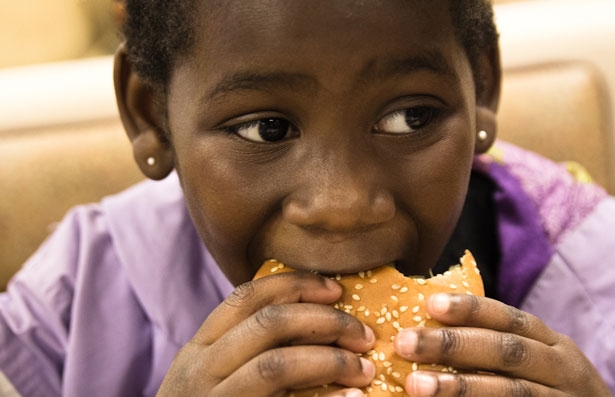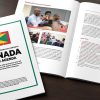By Greg Kaufmann
(Courtesy of Flikr user Steven Depolo, CC 2.0)
I get it, we need to play defense.
There are 50 million people who are food insecure—meaning they can’t meet their basic food needs and don’t necessarily know where their next meal is coming from—and yet both Democrats and Republicans are debating how muchmore to cut from a food stamp program that was already cut on November 1 and now has an average benefit of only $1.40 per meal…
We need to play defense.
At a time when the economy needs to add 8.3 million jobs just to return to pre-recession employment levels—and sequestration will result in the loss of nearly 1 million more jobs by the third quarter of 2014…
We need to play defense.
At a time when we have reached crisis levels of poverty for children of color under age 5—more than 42 percent of African-American children and 37 percent of Latino children under age 5 live below the poverty line of $18,300 annually for a family of three—and sequestration has resulted in more than 57,000 children being kicked out of Head Start classrooms…
We need to play defense.
At a time when there are record levels of homeless students in US public schools—nearly 1.2 million in the 2011–12 school year—and sequestration will result in as many as 185,000 low-income families losing housing assistance by the end of 2014…
We clearly need to play defense.
But then there is also this: anger, frustration, worry, rage, sadness and despair across the nation. It’s combustible. Ninety-five percent of the recovery gains since 2009 have gone to the top 1 percent, 60 percent have gone to the top .1 percent who earn more than $1.9 million annually. That doesn’t leave much for anyone else to get ahead.
So isn’t this actually the perfect moment for the anti-poverty community to pivot to offense? To rally around a tight, shared vision—one that appeals to people living in poverty or near poverty, and to the middle class?
In January of this year, I proposed an anti-poverty contract to unite groups around the minimum wage, paid leave, affordable childcare, subsidized jobs/TANF reform and ending childhood hunger. I shared the contract with advocates in DC and outside of the nation’s capital as well. The reaction? Roll soundtrack: crickets chirping (with a few notable exceptions).
As we approach the new year, I still think advocates are too segregated from one another, working on their specific issues, rather than increasing their power and numbers by coming together around a shared vision with popular appeal.
So I again sent some great leaders in the anti-poverty community a scaled back version of my previous proposal, asking whether they thought organizations could and should unite around three or so core issues. For purposes of discussion I proposed:
Raise the minimum wage: no one in America should work full-time, or two or even three part-time jobs, and still be stuck in poverty. Historically, a full-time worker earning the minimum wage could lift a family of three out of poverty. The Harkin-Miller proposal of a $10.10 per hour minimum wage would return us to that standard. (It also would raise the tipped minimum wage—stuck at $2.13 per hour for more than twenty years—to 70 percent of the minimum wage.)
Paid sick and family leave: nobody in this country should have to choose between a paycheck and caring for themselves or a sick family member, and yet only 34 percent of low-wage workers had access to paid sick leave in 2013.
Affordable, quality childcare: it’s tough to go to work and get ahead when there isn’t a safe, affordable place to take your kids for childcare, and yet childcare assistance policies worsened in twenty-four states in 2012. The average annual fee for full-time childcare ranges from $3,900 to $15,000.
The advocates I reached out to include: Sister Simone Campbell, executive director of NETWORK, a catholic social justice lobby; Dr. Mariana Chilton, director of the Center for Hunger-Free Communities, which includes the Witnesses to Hunger project; Steve Savner, director of public policy for the Center for Community Change; Deborah Weinstein, executive director of the Coalition on Human Needs; Melissa Boteach, director of Half in Ten and the Poverty and Prosperity Program at the Center for American Progress; and Jessica Bartholow, legislative advocate at the Western Center on Law and Poverty.
Here are some of the insights they offered and common themes that emerged from our conversations:
There is a need for a shared agenda among advocacy organizations.Sister Simone Campbell: I’ve been thinking how Speaker John Boehner is not a leader for the twenty-first century. And it got me thinking, ‘What are we doing for the twenty-first century?’ NETWORK’s Nuns on the Bus is like a lightning rod for hope and opportunity. That experience for me touched the hunger for community—and there’s a hunger for community not just for folks around the country—but also for those of us who do advocacy in DC.
Dr. Mariana Chilton: Housing groups and hunger groups, labor and immigrants rights groups, childcare groups and education groups—we need to all be talking and all have the same platform. We are too caught up in our own talking points for our own particular issues, and what that does is, ultimately, it chops up regular human beings—we’ve got to pull together as regular human beings, to humanize the issues of poverty, and hunger, and injustice.
Steve Savner: We agree with the idea that we need a small set of key demands that will connect with people in meaningful way. Since no three things will address all of the issues that folks face, the fight on some core demands also needs to connect to a broader vision and narrative about economic justice and eliminating poverty that allows us to build more power as we go from one fight to the next.
Jessica Bartholow: The best efforts to thwart austerity measures will not work unless there is a strong coalition that knows not only what it doesn’t want but what it does want, and that can unite across fissures in coalition and movement building to achieve that. We need to articulate a vision that is simple enough and urgent enough to build momentum in a short period of time, while conceding the need to go much farther with shared work on other issues down the road.
Melissa Boteach: While we definitely have to continue to defend the critical safety net programs under attack, we know we’re not going to reach Half in Ten’s goal of cutting poverty in half from a crouched, defensive posture. Anti-poverty advocates have got to come together and press for an agenda that speaks to the pressing task of rebuilding the middle class, and creating ladders of opportunity so that more people can reach the middle class.
Which issues should be selected and how should they be determined?
Savner: Folks here don’t feel like we are at a place to name the most resonant demands absent, at least for us, more testing on the ground directly in low income communities—both as to content and how to engage a lot more people in the fight. The broader vision behind the demands you name feels right, a decent job that pays fairly and a system that doesn’t force people to choose between a good job and a safe and healthy family. One more element I’d say the vision needs to address is the right to a decent jobs for all who seek them and fair access for those who are struggling to succeed in the labor market, such as people returning home from jail or prison, or who have been excluded from certain industries and occupations, most importantly women and people of color.
Chilton: The people are missing from this idea. If we all just get around these three issues it will just be a little sign-on thing that’s just going to fizzle out, unless you have people who are poor running the show. If it’s just words, ‘we hereby decree,’ it’s not going to get anywhere. The movement can be facilitated by the NGOs and non-profits, but it’s going to have to be the people who are poor that are supposedly represented by these organizations who need to be out front. Also, while I personally like this idea of having a simplified message: minimum wage, paid leave, and childcare as three top-ticket items, there’s a fourth ticket, and that’s people who are low-wage workers need to rise up, and it needs to get beyond the fast food industry and WalMart. People who are on SNAP benefits and working need to protest. And we need to join them.
Deborah Weinstein: It would be interesting to see if we could get broad support for a narrow positive agenda, and if so, what would it include? For me, minimum wage and paid sick leave are two easy choices. If there’s a third, it’s less obvious to me what [it] should be. Increasing the amount of the SNAP food benefit? A renter’s credit (refundable) combined with transforming the home mortgage interest deduction to a credit—which would save money by reducing the huge amounts going to the highest income homeowners? More childcare, perhaps combined with universal pre-k? Immigration reform?
Sr. Simone: I like the idea that we could focus on some key principles and make it proactive—but not as an adversarial scold—but as ‘We the People are better than this.’ And ‘work needs to pay.’ While we need to keep nudging at specific issues, there’s a much bigger hunger to get the community together, to recover ‘We the People…’ If we put the specific issues in that bigger context—they kind of hang together for the benefit of the 100 percent, for everybody. But we have to put it in the communal context without fear of each other.
Boteach: Grassroots partners are already calling for an end to the politics of austerity. To set the positive vision, low-income people have to be leaders in shaping and organizing around the unified agenda, but clearly a few wins on policies that have widespread appeal could make an enormous difference for low-income families. Raising the minimum wage commands strong public support across party lines—we just need to make sure members of Congress get the memo. Paid family leave and investments in childcare and pre-K would not just cut poverty; they’d help families of all income levels balance breadwinning and caregiving.
Bartholow: I read your blog calling for a national contract for shared prosperity on the birthday of Dr. Martin Luther King. That night, I stayed up laying out the policy asks that had surfaced through coalition work I have been engaged in. In California, we have finally been able to move from a decade of simply defending against cuts to articulating our shared vision for a vibrant, inclusive economy. New alliances have formed between women, immigrants, the working poor, people without homes, people formerly incarcerated, food stamp recipients, labor union members, college students, youth and others. So I shared my draft not only with these communities and organizations I work with, but with colleagues in other states and people working at the national level. Each conversation surfaced new insights, confirmed the need for an organizing vehicle like this, and raised very good—and still somewhat unanswered—questions about the long-term goals of the organizing effort. We hope to roll out our National Call to Action soon.
What would this movement look like if it were to be effective?
Chilton: I think it takes a march—and it has to be massive, bigger than the number of people who showed up for President Obama’s inauguration. It has to show that we are fed up. Then we could signal to the rest of the country that there are many of us just like you that are fed up—join us. I think people are waiting for something massive, for something like a familiar social movement. Something a little different from Occupy Wall Street—something that makes people head to DC with something like a banner of three key demands. Something that really includes and speaks to families with children. But who are the ones that could pull it together? Is it the Community Action people? Is itMomsRising? The labor movement? Who has the people to make it happen—to get the buses going and to roll with it?
Bartholow: Our Call to Action is designed to be an ongoing, relentless campaign informed, inspired and driven by the experiences of the people who are most impacted by stagnant poverty and historic levels of inequality. It will hopefully broaden the anti-poverty community through a time-sensitive, narrowly drawn campaign that supports active federal legislation.
Boteach: If this were to happen, it would mean that there has finally been a realization that the interests of low- and middle-income Americans are aligned. That’s the way we will achieve a broad-based movement. We are committed to working with our partners to make the case, build the power, and hold our leaders accountable to enact policies that cut poverty and rebuild the middle class.
Savner: At the Center for Community Change, we are indeed trying to build a nationwide movement against poverty. The core issue is jobs: making sure that good jobs are available and accessible to everyone. We will start at the local and state level, working with grassroots groups to win breakthroughs and redefine the possible. We’ll support massive new organizing among low-income people, build coalitions at both the state and national level, communicate the problems and the solutions, and working with others, we will make sure that good jobs for all—as a way to address poverty—is a central agenda for politicians who are running for office.
Sr. Simone: If this effort were successful we would know that we have each other’s backs. We would not need to be afraid of being left out…. We can make this happen if we try.
What do you think? Please comment below or email me at weekinpoverty@me.com
Get involved
The Time is Now: Tell Congress to Protect SNAP
Find a protest at a Walmart near you
Take Action: Urge Your Senators to Raise the Minimum Wage
Publix: Join the Fair Food Movement
Strong Start for America’s Children Act
War on Poverty Storyteller Contest
A Tale of Two Thanksgivings
Events
Getting Back to Full Employment with Dean Baker and Jared Bernstein (Tonight, November 25, 6:30–8 pm, Busboys and Poets’ Cullen Room, 5th and K Streets NW DC)
Roundtable on the Promotion of Health Equity and the Elimination of Health Disparities (Thursday, December 5, 8 am Pacific, Beckman Center, Irvine, California) The Institute of Medicine will hold a workshop exploring the history of social movements for lessons and strategies that could inform contemporary efforts to improve the health and well-being of all communities. The workshop will be webcast live.
Witnesses to Hunger 5-Year Anniversary Exhibit & Reception (Wednesday, December 11, 6–9 pm, Drexel University’s Bossone Research Center, First Floor Lobby and Mitchell Auditorium, 3140 Market Street, Philadelphia, Pennsylvania) In 2008, a group of women from North Philadelphia were given cameras to take pictures and speak out about their firsthand experiences with hunger and poverty for a project known as Witnesses to Hunger. Today, there are more than eighty Witnesses in sites from Boston to Baltimore. Join them for a night of reflection, celebration and action.
Clips and other resources
“Native Americans Are Less Likely to Be Employed Than Whites in Nearly Every State,” Algernon Austin
“Paul Ryan, Poverty Warrior? Huh?,” Jared Bernstein
“Getting Back to Full Employment: A Better Bargain for Working People,” Jared Bernstein and Dean Baker
“Inside The Death Of A D.C. Public School,” Kavitha Cardoza
“Actually, the Fed Can Do Something (Lots, Even) About Inequality,” Josh Bivens
“Inequality Is (Literally) Killing America,” Zoë Carpenter
“Justice Center Helps Reduce Crime and Incarceration in Brooklyn,” Center for Court Innovation
“Infographic: The School-Readiness Gap,” CAP Early Childhood Team
“We Have Skilled Construction Workers−They Need Jobs,” Ross Eisenbrey
“As I See It—Declaring a new war on poverty,” William Elliott III
“Gathering insights from Native American communities,” Lionel Foster
“Congress Must Not Break 40-Year Commitment to Let WIC Provide Most Nutritious Food,” Robert Greenstein
“Child poverty remains high while spending on children falls,” Julie Isaacs
“Expanding Social Security,” Paul Krugman
“The Long-Term Unemployment Trap Could Get Worse,” John Light
“In rural Kentucky, health-care debate takes back seat as the long-uninsured line up,” Stephanie McCrummen
“Education for Homeless Children and Youths Program Data Collection Summary,” National Center for Homeless Education
“Healthy Relationships, Employment and Reentry,” National Transitional Jobs Network
“There is not enough affordable rental housing,” Erika Poethig
“Access to Healthy Food and Why It Matters: A Review of the Research,” PolicyLink and The Food Trust
“SNAP Costs Leveling Off, Almost Certain to Fall Next Year,” Dorothy Rosenbaum
“Focus of US Fiscal Policy Must Shift Back to Full Employment,” William Spriggs
“The Detroit Bankruptcy,” Wallace Turbeville
“Breaking Bread to Build a Movement: Harnessing Philanthropy’s Power to Convene,” Luz Vega-Marquis
Vital StatisticsUS poverty (less than $23,492 for a family of four): 46.5 million people, 15 percent.
African American poverty rate: 27.2 percent.
Hispanic poverty rate: 25.6 percent.
White poverty rate: 9.7 percent.
People with disabilities: 28 percent.
Poorest age group: children, 34.6 percent of all people in poverty are children.
Children in poverty: 16.1 million, 21.8 percent, including 38 percent of African-American children, 34 percent of Latino children and 12 percent of white children.
Poverty rate among families with children headed by single mothers: 40.9 percent.
Gender gap: Women 31 percent more likely to be poor than men.
Deep poverty (less than $9,142 for a family of three): 20.4 million people, 1 in 15 Americans, nearly 10 percent of all children, up from 12.6 million in 2000—an increase of 59 percent.
Homeless students in K-12 public schools: 1.2 million.
Twice the poverty level (less than $46,042 for a family of four): 106 million people, approximately one in three Americans.
Jobs in the US paying less than $34,000 a year: 50 percent.
Jobs in the US paying below the poverty line for a family of four, less than $23,000 annually: 25 percent.
Poverty-level wages, 2011: 28 percent of workers.
Federal minimum wage: $7.25 ($2.13 for tipped workers).
Federal minimum wage if indexed to inflation since 1968: $10.59.
Federal minimum wage if it kept pace with productivity gains: $18.72.
Families receiving cash assistance, 1996: 68 for every 100 families living in poverty.
Families receiving cash assistance, 2012: 25 for every 100 families living in poverty.
Impact of public policy, 2011: without government assistance, poverty would have been twice as high—nearly 30 percent of population.
Number of people 65 or older kept out of poverty by Social Security: 15.3 million, including 9 million women.
This Week in Poverty posts again at Moyers & Company. You can e-mail me at WeekInPoverty@me.com and follow me on Twitter.
Five community members met with Congressional leaders to discuss the dire implications of cuts to food stamp spending.













![AEO, Ras Kass, Nkechi Taifa, Kymrence Young & Tricky Trev.) (feat. Young RJ [Slum Village], Ras Kass, Nkechi Taifa & Kymrence Young)](https://ibw21.org/wp-content/uploads/2024/12/organizing-anthem-AEO-Agitate-Educate-Organize-1600x900-1-100x100.jpg)


